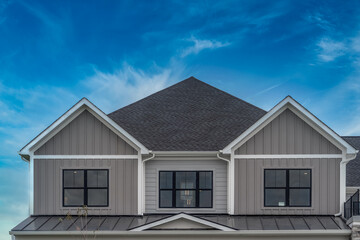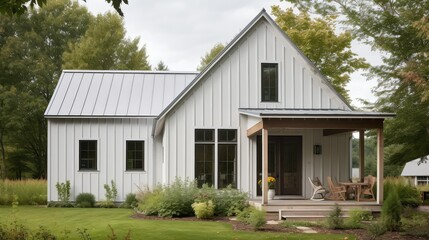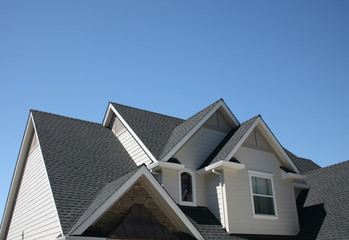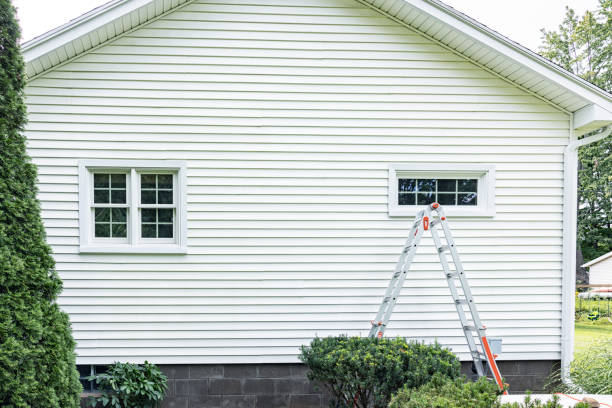Vertical vinyl siding is gaining popularity among homeowners who want something modern, low-maintenance, and cost-effective. It’s a bold alternative to traditional horizontal siding and gives homes a sleek, tall appearance. While this design choice comes with undeniable benefits, it may not suit every house or homeowner’s needs.
So, is vertical vinyl siding right for you?
In this comprehensive guide, we’ll explore everything you need to know. We’ll discuss the pros and cons, compare it to other siding types, and explain when it’s a smart investment and when it’s not.
Whether you’re looking to improve curb appeal or reduce exterior maintenance, vertical siding vinyl could be the solution. But it’s important to understand its long-term benefits and potential drawbacks. Some love its bold design, while others find it hard to match with traditional architecture.
Table of Contents
What Is Vertical Vinyl Siding?
Vertical vinyl siding is a type of siding where panels are installed from top to bottom instead of side to side. It’s often seen in farmhouse, barn-style, or modern homes but is increasingly used in residential and commercial settings.
There are several types of vertical siding styles:
- Board and Batten: Wide vertical boards with thin strips (battens) covering the seams.
- Panel Siding: Smooth or textured sheets that offer a clean, minimalist look.
- Plank Style: Long vertical planks that mimic real wood.
The material is made from PVC (polyvinyl chloride), making it durable, lightweight, and resistant to weather and pests.
Key Benefits of Vertical Vinyl Siding
1. Distinctive Appearance
One of the main reasons homeowners choose vertical siding is its visual impact. It creates the illusion of height, adds a modern touch, and helps the home stand out.
2. Low Maintenance
Vertical vinyl siding is easy to clean. A garden hose and mild soap are usually enough. It doesn’t need to be painted or sealed like wood siding.
3. Durability
Vinyl is resistant to insects, moisture, and rot. It can last 30–40 years or more with proper care.
4. Cost Efficiency
Vinyl siding is more affordable than wood or fiber cement. While vertical installation may be slightly more expensive, overall costs remain budget-friendly.
5. Versatile Design
With various colors, textures, and patterns, vertical siding can match multiple home styles, from modern to rustic.

Common Drawbacks of Vertical Vinyl Siding
1. Complicated Installation
Installing vertical siding takes more time and skill. It often requires furring strips to ensure a flat surface and proper alignment.
2. Potential for Visible Seams
Some vertical panels can leave noticeable seams that interrupt the clean appearance, especially on large walls.
3. Less Traditional Appeal
In neighborhoods where horizontal siding is the norm, vertical styles might appear out of place.
4. May Not Suit All Homes
Vertical vinyl siding may clash with colonial, Victorian, or craftsman-style homes, where horizontal lines are more fitting.
Vertical Vinyl Siding vs Horizontal Siding
| Feature | Vertical Vinyl Siding | Horizontal Vinyl Siding |
| Appearance | Tall, sleek, modern look | Traditional, familiar aesthetic |
| Installation | More complex, needs furring strips | Simpler, faster installation |
| Cost | Slightly higher labor cost | Lower labor cost |
| Maintenance | Easy to clean and maintain | Easy maintenance |
| Ideal Uses | Modern, farmhouse, commercial | Classic residential styles |
| Design Flexibility | Bold, standout accent walls | Uniform full-home coverage |
Design Tips for Using Vertical Siding Vinyl
- Use as an Accent: Mix vertical vinyl with horizontal siding to highlight architectural features like gables or entryways.
- Pair with Natural Elements: Combine with stone or wood to add texture.
- Choose Bold Colors: Dark grays, blues, or black vertical siding creates a striking contrast.
- Stick to Simplicity: Too many textures can overwhelm the look. Keep it clean.
When to Choose Vertical Vinyl Siding
Consider vertical siding vinyl when:
- You want a modern or farmhouse exterior.
- You’re upgrading a garage, barn, or commercial building.
- You’re using it as a feature wall or design accent.
- You want low maintenance and weather resistance.
- You plan to live in your home long-term and want lasting durability.
When to Avoid Vertical Vinyl Siding
Avoid it if:
- Your home has a traditional or colonial design.
- The HOA has strict rules about exterior styles.
- You’re planning a DIY project (installation is tricky).
- You want a uniform siding style that blends in with other homes nearby.
Maintenance Tips for Long-Term Value
Keeping vertical vinyl siding looking great doesn’t take much, but a few steps can go a long way:
- Clean once or twice a year with soap and water.
- Avoid pressure washing, which can force water behind panels.
- Inspect for damage after storms.
- Keep nearby shrubs trimmed to prevent scratching.

Environmental Impact
Vinyl siding is not Safe for the environment, but it’s recyclable. Look for manufacturers that use recycled content. It also reduces energy bills when installed with insulated panels.
Many vertical vinyl siding options today come with energy-efficient backings that improve your home’s insulation and reduce heating and cooling costs.
Final Thoughts
Vertical vinyl siding offers homeowners a modern, bold exterior that’s both functional and stylish. From its easy maintenance and long lifespan to its unique appearance, it’s a worthy option for many but not all homes.
Whether you’re remodeling your house, upgrading a garage, or designing a new build, vertical siding vinyl may be just the feature that sets your property apart.
If you’re unsure whether vinyl vertical siding is the right choice for your Maryland or Virginia home, we’re here to help. Our experts at United Developers MDVA can offer guidance, product selection, and expert installation tailored to your style and budget.
Contact Us
Have questions or ready to start your siding project?
Contact United Developers MDVA today for a free consultation and quote.



Hi, this is a comment.
To get started with moderating, editing, and deleting comments, please visit the Comments screen in the dashboard.
Commenter avatars come from Gravatar.